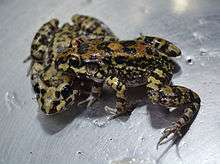Leptodactylus troglodytes
Leptodactylus troglodytes (common names: Pernambuco white-lipped frog,[2] hole-dwelling thin-toed frog,[3] sibilator frog[3]) is a species of frogs in the family Leptodactylidae. It is endemic to northeastern Brazil and occurs from northern Minas Gerais and Bahia to Maranhão, Piauí, Ceará, and Rio Grande do Norte.[1][2] The specific name, troglodytes, refers to its habit of breeding in underground chambers.[4]
| Leptodactylus troglodytes | |
|---|---|
 | |
| Scientific classification | |
| Kingdom: | Animalia |
| Phylum: | Chordata |
| Class: | Amphibia |
| Order: | Anura |
| Family: | Leptodactylidae |
| Genus: | Leptodactylus |
| Species: | L. troglodytes |
| Binomial name | |
| Leptodactylus troglodytes Lutz, 1926 | |
Description
Adult males measure 46–53 mm (1.8–2.1 in) and adult females 45–53 mm (1.8–2.1 in) in snout–vent length. The tympanum is distinct.[4] Males have more acuminate snout than females.[3] Dorsal folds are absent and dorsolateral folds are indistinct or (usually) absent; lateral folds are also absent or interrupted. The belly is uniformly light.[4]
The tadpoles grow to 43 mm (1.7 in) in total length (Gosner stage 36).[4]
Reproduction
This species builds foam nests in underground chambers near water.[1][3] Single tunnel may have multiple chambers. Males are territorial and emit territorial as well as courtship calls, to which the female may reciprocate.[3]
Habitat and conservation
Leptodactylus troglodytes is a common species that occurs in dry and moist savanna and agricultural land in the Cerrado and Caatinga ecosystems and in dune systems in Atlantic Rainforest zone. It is impacted by intensive agriculture, overgrazing by livestock, and fire, but is not considered threatened as species.[1]
References
- Arzabe, C.; Heyer, R. (2010). "Leptodactylus troglodytes". IUCN Red List of Threatened Species. 2010: e.T57171A11595328. doi:10.2305/IUCN.UK.2010-2.RLTS.T57171A11595328.en.
- Frost, Darrel R. (2016). "Leptodactylus troglodytes Lutz, 1926". Amphibian Species of the World: an Online Reference. Version 6.0. American Museum of Natural History. Retrieved 22 February 2016.
- Kokubum, Marcelo N. de C.; Maciel, Natan M.; Matsushita, Rubens H.; Teixeira Junior, Armando de Queiroz; Sebben, Antonio (2009). "Reproductive biology of the Brazilian sibilator frog Leptodactylus troglodytes". Herpetological Journal. 19 (3): 119–126.
- de Sá, Rafael O.; Grant, Taran; Camargo, Arley; Heyer, W. Ronald; Ponssa, Maria L. & Stanley, Edward (2014). "Systematics of the Neotropical genus Leptodactylus Fitzinger, 1826 (Anura: Leptodactylidae): Phylogeny, the relevance of non-molecular evidence, and species accounts". South American Journal of Herpetology. 9 (Spec. Issue 1): S1–S100. doi:10.2994/sajh-d-13-00022.1.
